Until recently, a few people could afford a floor heating system using water heating. Now, the arrangement of underfloor heating has become much more affordable, as more affordable components have begun to appear on the building materials market, which are used to assemble a pipe underfloor heating system. Now for these purposes pipes from several types of materials are used.

Next, we will analyze the advantages and disadvantages of different types of pipes that can be used for arranging underfloor heating, which will give you the opportunity to choose the ones that are more suitable for you.
General requirements for materials for underfloor heating
Given the unusual operating conditions, certain, fairly strict requirements are imposed on the materials that are used to install the underfloor heating system. Indeed, in the event of breakdowns or leaks, you will have to completely remove the floor covering, dismantle the screed and the heating system itself, and then do it all over again. To avoid this, the selection of pipes must be treated very responsibly, and make sure that they meet the following characteristics:
- durability and reliability, that is, the service life of products should not be less than 40-50 years;
- elasticity, that is, the ability to bend and at the same time not lose tightness at the bends;
- strength to withstand mechanical pressure;

- low cost, taking into account the fact that the length of thermal water communications in the floor is quite large;
- a sufficient coefficient of thermal conductivity so that the heat transfer from the circulating hot liquid is transferred faster to the floor surface;
- impermeability to oxygen molecules, which in certain concentrations in the coolant can adversely affect the metal elements of the system, causing corrosion.
And now let's look at the pipes from which materials fully or partially meet these requirements.
Warm floor polypropylene
Pipes made of this polymeric material are often used for arranging underfloor heating. Such products in many respects are ideal for underfloor heating.
They have sufficient strength, which is necessary in these operating conditions. However, strength is characteristic only of reinforced polypropylene pipes, which are used for this purpose. Moreover, the reinforcing layer should be represented by a layer of continuous foil, which, in addition to strength, makes a barrier to molecular oxygen.
In addition, polypropylene belongs to chemically inactive substances, which, firstly, eliminates corrosion, and secondly, makes the system suitable for using any type of coolant.
At the same time, polypropylene has a good coefficient of thermal conductivity, which favors quick warm-up gender.
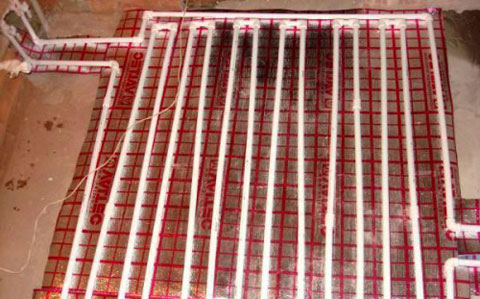
The disadvantage of polypropylene pipes is that they are difficult to bend. In order to bend them, one has to resort to heating the material with a stream of hot air, for example, with a building hair dryer. But even with this, the bending radius is large enough and it is not enough to lay the underfloor heating loops tightly enough.
Therefore, in order to form a system with a sufficiently small pitch of heating elements, corner fittings are used that connect individual polypropylene sections.
For a tight connection, the method of soldering polypropylene elements using a special welding machine is used.
The places of such connections with high-quality soldering of joints must be absolutely tight. However, after the complete installation of the polypropylene underfloor heating, it is necessary to test the system. To do this, for 1-2 days, she needs to be allowed to work at a pressure increased by 1.5-2 times compared to normal. If at the same time no leaks or at least minor instillations are found anywhere, you can close the polypropylene floor heating with a screed and continue subsequent work. If even a slight leak is detected, this place must be resoldered after draining the liquid, and then tested again.
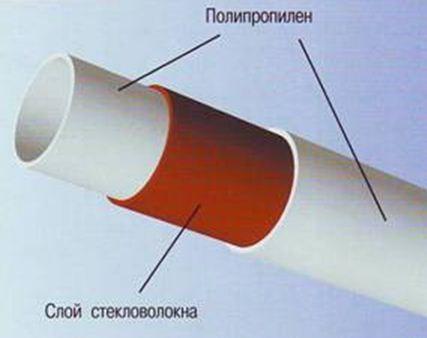
Despite some disadvantages, mainly related to the duration and relative complexity of installation, floor heating made of polypropylene components is still very popular due to the low cost of both pipes and connecting elements to them.
Metal-plastic for water floor heating
Metal-plastic pipes are very often used for the described purposes. And there are reasons for that. The material bends perfectly, and it is not necessary to heat it for this. This makes it possible to lay metal-plastic elements of any configuration and density of turns without any extra effort, as well as the use of fitting connections. In addition, metal-plastic pipes are sold in coils, where their length is up to 50 m, which makes it possible to lay a system without joints in small and medium-sized rooms. By the way, under the order you can buy a bay of metal-plastic 80-90 meters, which will be enough for a fairly large area.
Pipe structures made of metal-plastic are also good because they absolutely do not let in oxygen that destroys metal elements of the system, which has a positive effect on the durability of underfloor heating and water heating in general.
In addition, metal-plastic has a good coefficient of thermal conductivity, which contributes to the rapid heating of the floor surface.
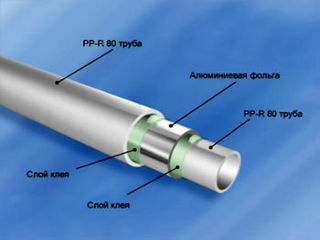
For the purposes described, metal-plastic products are used that have a diameter of 16 mm (half an inch) and 20 mm (three quarters). It is not advisable to use an inch metal-plastic pipe for several reasons. Firstly, it is quite expensive, especially if you buy a quality metal-plastic product. Secondly, the bending radius is greatly increased, which directly depends on the pipe diameter. Thirdly, you have to fill in a fairly thick screed, which also entails additional costs.
Metal-plastic underfloor heating at the cost of material and work is probably one of the most affordable. The pipes themselves, especially if the metal-plastic is of high quality, are relatively expensive. However, taking into account the fact that it is not necessary to use connecting elements in the floor, the whole system turns out to be quite economical.
Underfloor heating using polyethylene materials
For water floor heating, pipes made of the so-called cross-linked polyethylene are used.“Stitched” does not mean at all that it is made from separate fragments and therefore of poor quality. On the contrary, such polyethylene has excellent strength indicators and is quite flexible at the same time. And it is cross-linked at the molecular level when certain chemical or physical factors are exposed to the substance.

Cross-linked polyethylene is increasingly being used for arranging underfloor heating. The material itself is, of course, quite expensive. However, cross-linked polyethylene is very easy to use and meets all the above requirements, including durability and high thermal conductivity.
In conclusion, it is worth noting that the building materials market is constantly updated with new products from manufacturers. Therefore, it is possible that soon other materials will be used to equip the heated floor. The same article describes the most popular and used today.
Modern cozy house it is impossible to imagine without an efficient and high-quality heating system, including underfloor heating. Despite the fact that this convenient innovation appeared not so long ago, its reliability, ease of operation and cost-effectiveness has already won the trust of many consumers. Underfloor heating is not only productive, but also pleasant. After all, even in winter, you can walk around the house barefoot, and at the same time feel warm and comfortable.
But how to make warm floors with your own hands? Cope with on their own it’s not difficult at all, since the modern market pleases with a lot of high-quality and affordable materials. One of them is polypropylene pipes, which have become an effective and promising participant in this heating system. Let's consider how to make a warm floor with your own hands: a photo, in more detail, in order to avoid mistakes in the process of its installation.
Polypropylene pipes have become an excellent alternative to traditional metal products.
Appearance of polypropylene pipes
Due to their characteristics, they are widely used in various engineering systems:
- internal hot and cold water supply;
- heating systems;
- sewer networks;
- for transportation of aggressive media, which is ensured by the chemical resistance of products;
- if underfloor heating is required.
The practicality and quality of polypropylene pipes determine a great demand for them and allow them to be used to solve important problems in different environments: in channels, walls, shafts, under plaster and in any soil.
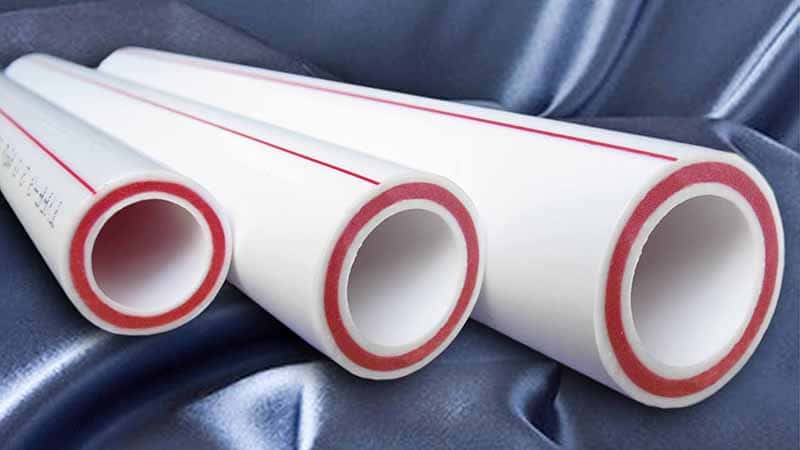
Polypropylene pipes for underfloor heating system
Advantages of polypropylene pipes
The benefits of these products include:
- Durability- subject to the basic rules for operating the system, as well as the temperature regime in it up to 75 degrees, the products can last more than 25 years.
- Seam tightness is ensured by the use of a special technology for connecting the individual components of the pipeline using a soldering iron.
- Elasticity, high mechanical strength and frost resistance. Even if the transported liquid freezes, the products expand slightly and then return to their original dimensions.
- Not susceptible to corrosion, are not afraid of exposure to solvents and acids, salt deposits on internal surfaces.
- Absence in them bacterial flora.
- Low thermal conductivity and the absence of condensate are due to the same temperature of the coolant at the inlet and outlet of the system.
- low cost pipes and connecting elements in comparison with alternative options. High environmental performance of the material allows not to harm the environment during its operation and disposal.
- light weight compared to steel products.
Polypropylene pipes used for underfloor heating are exposed to high temperatures and change their dimensions. Usually, the coefficients of thermal and linear expansion are fixed in their characteristics. Therefore, experts recommend during installation to give preference to products reinforced with fiberglass or aluminum.
Using Other Alternatives
Today, in addition to polypropylene, other types of inexpensive materials are used for heating systems, the quality of their work largely depends on the correct choice of which. For example, a cost-effective option for underfloor heating can be polyethylene pipes, which have excellent thermal conductivity and wear resistance.
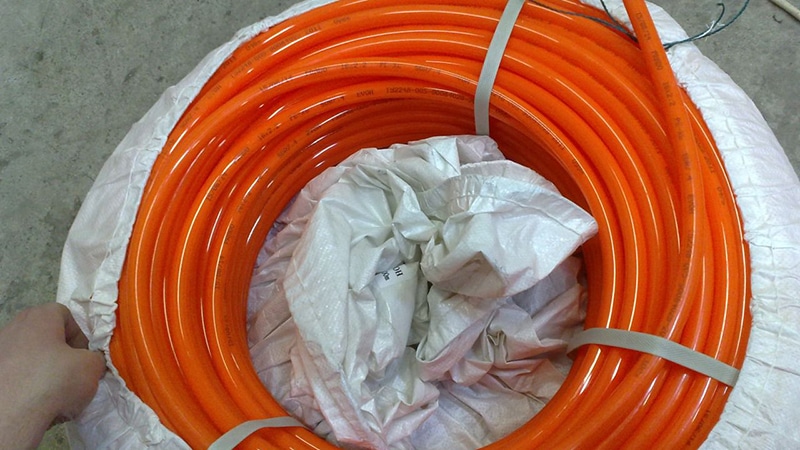
Polyethylene pipes
They, unlike the propylene counterpart, are less susceptible to expansion under the influence of sufficiently high temperatures. When installing pipes made of cross-linked polyethylene, they need to be rigidly fixed, otherwise they can straighten out, which is one of their main drawbacks.
Metal-plastic pipes are also in great demand, thanks to the inner aluminum layer they have good thermal conductivity, and polymer layers ensure their resistance to damage. Their small disadvantage is the internal formation of scale in places threaded connections fittings and higher cost compared to propylene counterparts.
![]()
Metal pipes for underfloor heating
Design and execution of underfloor heating
Such a system saves usable space, as it is located under any floor covering or cement screed. A warm floor made of polypropylene pipes with your own hands can be arranged by pouring them with concrete or other plasticizer. At the same time, the coolant circulates through them and evenly distributes heat, starting from the bottom throughout the room.
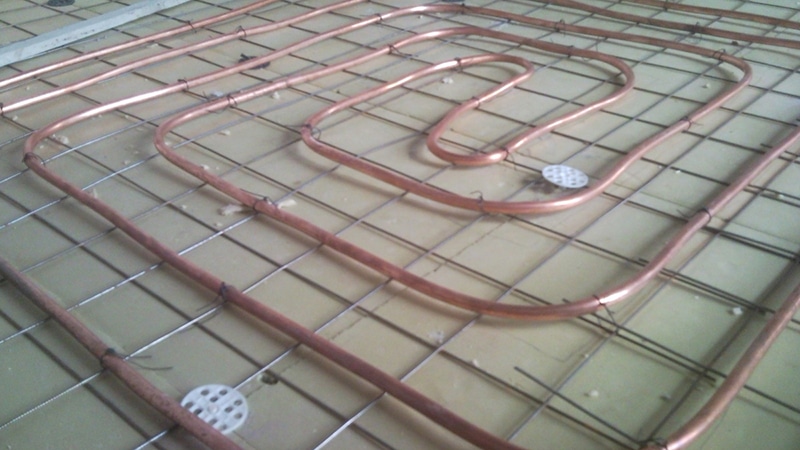
Appearance of the underfloor heating system
In this case, the source of heat can be a boiler or other types of heating. Temperature sensors provide timely shutdown of the system immediately after the set temperature is reached, which saves energy.
Do-it-yourself installation of a warm floor is carried out in several stages:
- project preparation;
- laying and connecting pipes;
- checking and monitoring the system performance;
- arrangement of the screed;
- finishing coating.
Let's consider in more detail all the stages.
It is impossible to make a warm floor without preparing a project, which is needed to calculate the need for materials, the heated area, the temperature that can ensure the operation of the system, the location of the boiler and other nuances, including the diameter and length of the pipes. For the efficient functioning of heating, it would be more correct to entrust all calculations to professionals.
Installation of the system begins with the installation of a collector cabinet, necessary for connecting the circuits to the base line, through which warm water is supplied and chilled water is taken.

Distribution manifold cabinet
The cabinet is installed above the floor level in order for the pipes to go down, while ensuring the removal of air and the normal functioning of the system.
One of the key points when installing underfloor heating is waterproofing, which can protect the room from water leaks. Film materials, such as polyethylene, are often used for this purpose.
To prevent cracking of the screed during thermal expansion, experts recommend using a damper tape, which is glued around the perimeter of the room.
In order to reduce heat losses, thermal insulation is installed that can cope with heavy loads and has a high thermal resistance. For this purpose, a foil coating is used, which has excellent mechanical strength, a small degree of compression and evenly distributes heat over the floor surface. A reinforcing metal mesh is used to fasten pipes and fix the screed.
Contour laying rules
To ensure the efficient operation of this heating system, compliance with the basic rules for laying circuits is required. Their total length should not exceed 80 m. For uniform heating, the optimal length is up to 50 m, the standard diameter is 2 cm. The calculation of the contour and its step is performed for each individual room, especially if they have different temperature regimes.
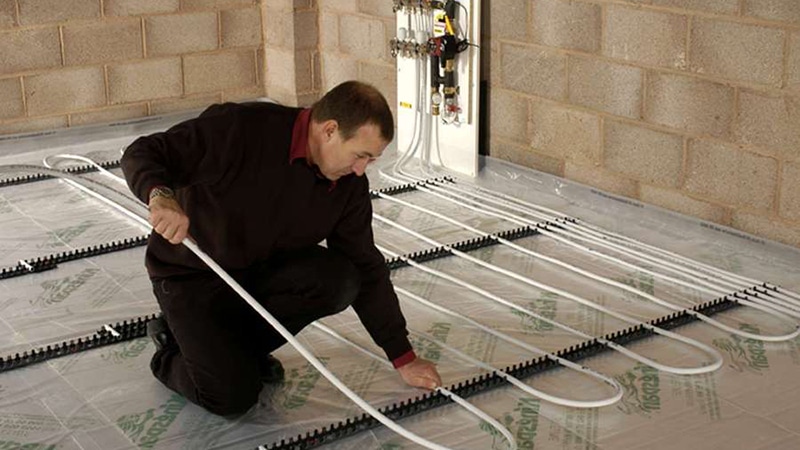
Underfloor heating process
Pipe laying can be performed using different schemes:
- spiral;
- double helix;
- snake - loops;
- snail.
The choice of a suitable scheme depends on the parameters of the room and functional purpose its zones. For example, a spiral circuit will ensure uniform heating of rooms that have the correct shape, and a snake is more suitable so that the hot coolant first gets into cold zones, and then heats other parts of the room.
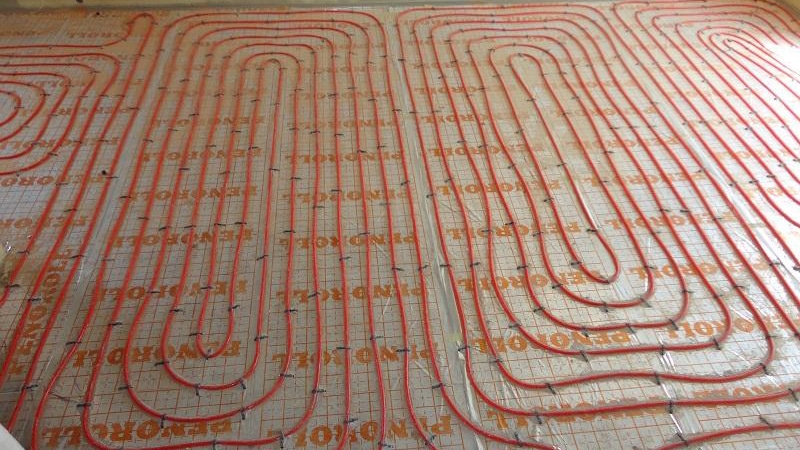
Spiral pipe laying
After laying polypropylene pipes, they are fastened with clamps to a metal reinforcing mesh. Then they are connected to the circuits, and the system is filled with water to check for leaks in it. The pressure in the system must be 1.5 times the working pressure, but not less than 6 bar. Further, the pressure is increased to the previous indicator every half hour at least 3 times, and then left for a day. If during this time the pressure does not drop by more than 2 bar, then the laying is done perfectly.
Arrangement of the screed
When pouring the floor with concrete, first, using a horizontal level, a beacon profile is installed, along which the surface of the screed is leveled. The laying of the final floor covering can be started no earlier than 28 days after the concrete has completely cured.

Floor screed when laying the heating system
Warm floors under a tile
Tiled floors are durable, they are not afraid of moisture and exposure to aggressive liquids. Therefore, many homeowners opt for an electric warm field followed by tiling.
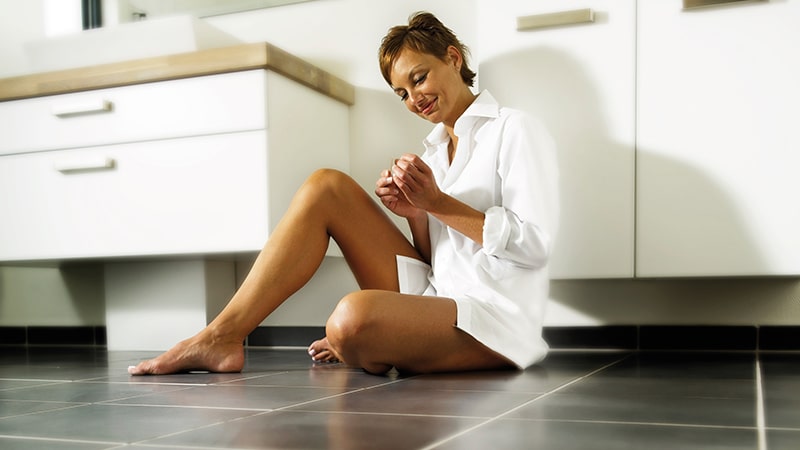
Tiled warm floor
In addition, they are economical, because they allow you to adjust temperature regime according to the season. The device of a warm floor under a tile is made cable, film and in the form of heating mats. Consider their pros and cons.
Cable underfloor heating system
Today, cable underfloor heating under tiles is used infrequently. Due to the high pie of this system, which includes a concrete screed up to 4 cm thick, the height of the room steals and the load on the base increases. Therefore, it is better to use it in rooms without decoration.
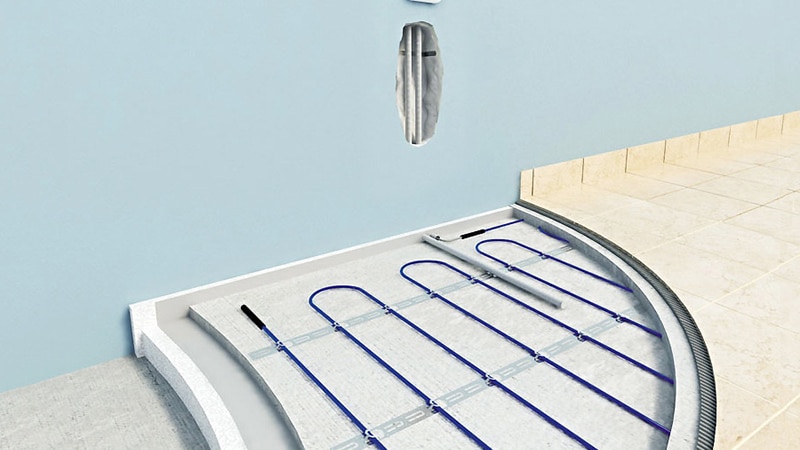
Cable floor heating system
Cheaper products include single-core cables. Their use is problematic in rooms with a complex layout, since there is a need for a thermostat. It is easier to lay higher twin-core options, the ends of which do not converge at one point. Such a floor is started after the screed or tile adhesive has completely hardened.
Warm floor from electric mats
This option is suitable for rooms with a concrete base. The mats have a base of thin cables embedded in a reinforced mesh. They are produced with a thickness of no more than 3 mm and do not reduce the height of the premises. The absence of screed and the minimum thickness of the heating mats make it possible to use such floors in rooms with low ceilings.
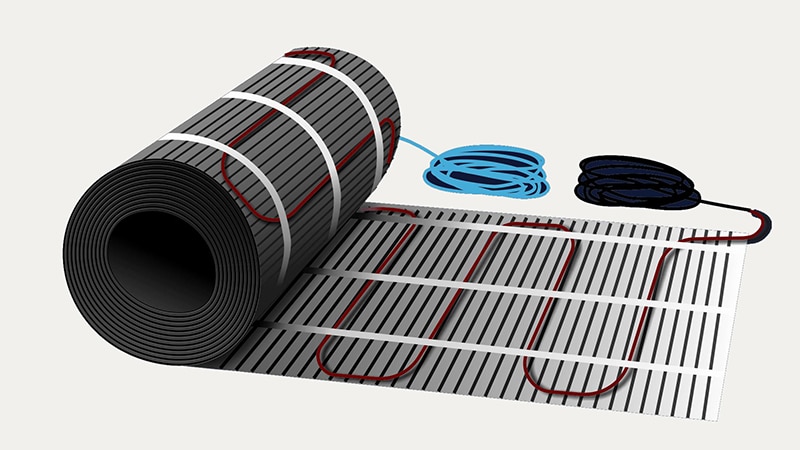
Appearance of mats with electric cable for underfloor heating
They are laid directly on the concrete, covered with tile adhesive, on which the tiles are fixed. Despite the ease of installation of this heating system, it is much more expensive than a cable counterpart.
Film floor option
Underfloor heating film under the tile is one of the most modern and efficient electrical systems.
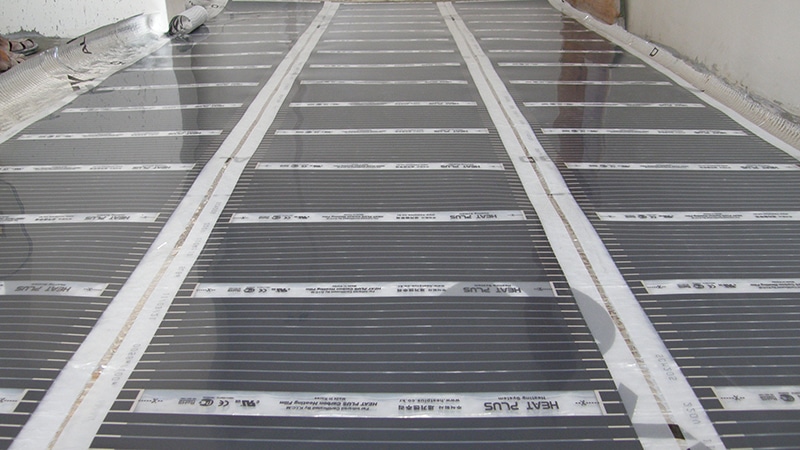
Film floor heating
It is easy to install and can be applied to all top coats. The heat carrier in the form of infrared radiation not only has a high efficiency, but is also harmless to health.
Now you know how to make a warm floor from heating with your own hands, and choosing the right option will allow you to independently create not only a reliable heating system, but also save on installation and commissioning.
There is a need for additional floor heating in all regions of our country: the first floors of residential buildings are cooled most of the year. The solution to the problem is the installation of a separate heating system under the screed. Most often, polypropylene pipes are used as a conductor.
Pipes: marking and the right choice
The marking of polypropylene pipes is the first thing they pay attention to when choosing a suitable conductor for hot water, since not every product is suitable for this purpose. What is hidden under encryption:
- Operating pressure PN, which the pipe must withstand during its entire service life at a water temperature of 20°C. For a warm floor, you should choose a designation not lower than PN20-25 - they are designed for hot water.
- Variety of material: PP - polypropylene. Its addition PP-1, PP-2, PPB indicates the type of raw material used - homopolymer or block copolymer. For hot water, pipes marked PPR, sometimes PPB, are suitable.
- The diameter of the conductors and the thickness of their walls in millimeters from 10 to 1200 mm. For internal systems heating and underfloor heating use pipes with an internal diameter of not more than 30 mm.
- Marking - designation of the manufacturer, year of manufacture.
Manufacturers
There is a lot of competition among pipe manufacturers in the market. Which ones to choose?
- Russian brands: Politek, PRO AQUA, Heisskraft, RVC, Santrade;
- Germany: Akwatherm, Banninger, Rehau, Wefatherm;
- Czech Republic: FV-Plast, Ecoplastic;
- Turkey: Pilsa, Kalde, TEBO, Firat, Vesbo and Jakko;
- China: Dizayn and Blue Ocean.
The characteristics of all products are indicated in the labeling and must comply with international standards. Which brand to choose - it is impossible to say unambiguously. It's a matter of personal preference.
Pros and cons of underfloor heating made of polypropylene pipes
Is it worth choosing products for organizing floor heating and can propylene pipes be poured with concrete under the screed?
Let's start with the pros of using the material:
- Resistance to temperature and pressure changes;
- Low thermal conductivity minimizes the loss of thermal energy;
- Low cost of pipes and their installation, maintenance;
- There are no deposits on the inner walls.
- The low flexibility of pipes with at least 8 diameters makes contours difficult";
- The temperature in the room during laying is limited - not lower than + 15 ° C;
- High coefficient of linear expansion - conductors can change their dimensions when exposed to hot water. Polypropylene pipes can be laid in the floor screed, but it is necessary to correctly calculate and select them so that there are no internal stresses that can lead to rapid wear.
How long does the heating system last?
With the right selection of material, the service life of polypropylene pipes reaches 25 years - this is exactly what conductive products are designed for. If errors are made during installation or the use of pipes with more low performance excessive stress in the walls may occur, which reduces the life of the polymer.
Styling features
First of all, a manifold cabinet is installed, to which the outgoing and return pipes are connected.
Be sure to lay waterproofing under the future "pie" to prevent the base from getting wet in case of a leak. For these purposes, polyethylene is used, overlapped and fixed with adhesive tape.
The damper tape around the perimeter of the room will save the screed from cracking after the solution has solidified during periodic expansion. Insulation throughout the floor area will keep the heat inside the room.
It is better to fasten the contour with the help of a reinforcing mesh, pressing the pipe with clamps. Here it is important not to overdo it and not pull the tube.
Laying is made from a coil, the length of one thread for effective heating should not exceed 50-80 meters.
Polypropylene pipes under the screed must be tested before pouring concrete: hot water under operating pressure. If the line is not deformed and everything went smoothly, the circuit is disconnected from the water supply, but left operating pressure online. After cooling, concrete is poured, to which special additives are added to improve the quality of the mixture.
You can use the finished floor only after the screed has hardened - not earlier than a month later.
Underfloor heating made of polypropylene pipes is popular because of its many positive properties. For do-it-yourself underfloor heating, it is more efficient to use these particular elements. Steel pipes are a relic.
Advantages
If you make floor heating with PVC pipes, you can achieve many advantages. These include:
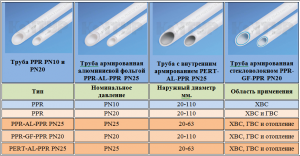
Flaws
When using polypropylene pipes for underfloor heating, it is necessary to use elements with reinforced walls. The use of conventional materials will reduce the life of the system. Unreinforced walls cannot cope with the high load from the circulating coolant under pressure. Also, a certain effect is observed from the screed and other elements of the warm floor.
How to install polypropylene pipes
Another disadvantage of polypropylene is its instability to high temperatures. Therefore, it is forbidden to use it in rooms with a high fire hazard. The normal operating temperature of polypropylene is +75°C (pressure up to 7.5 atm.). It can be operated at +95°C, but in this case, the service life is significantly reduced. Therefore, when installing an underfloor heating system, care must be taken to ensure that the coolant reaches the optimum temperature.
Varieties of polypropylene pipelines
Polypropylene pipes are popular for underfloor heating, water supply systems and other engineering networks in the house. They can be single layer or multilayer. Each option has its own scope.
Polypropylene pipes for water supply and heating systems
Single layer
Main varieties:
- RRN. Pipelines are made of homopolypropylene. Not used for underfloor heating, but widely used for water supply, ventilation systems;
- RRV. Manufactured from polypropylene block copolymer. Differ in the high durability and firmness;
- PPR. For production, a random copolymer polypropylene is used. Pipes made of this material are able to effectively distribute the produced load along their walls;
- PPs. Pipes of this type are inflammable. They are able to work effectively at temperatures that do not exceed +95°C.
Multilayer
There are several types of multilayer pipes, which are reinforced with a reinforcing layer of the following materials:
- aluminum. A thin reinforcing sheet is applied to the outer surface of the pipeline. When connecting several elements, the aluminum layer is cut off by 1 mm. There are also variations where reinforcement is carried out inside - between the walls. Polypropylene pipes with aluminum reinforcement are able to work effectively at a temperature of +95°C (for a short time at +110°C);
- fiberglass. The reinforcing layer is placed between the polypropylene sheets. These pipelines are effective in underfloor heating;
- composite. A mixture of aluminum and fiberglass fibers is placed between two layers of polypropylene.
Preparatory work for laying a warm water floor
It is impossible to make a warm floor using polypropylene pipes with your own hands if you do not properly prepare the base for their laying:
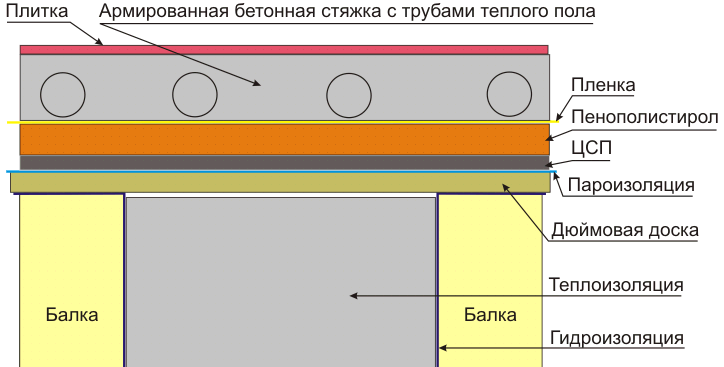
Calculation of the required pipeline length
Laying pipelines with your own hands in a screed should be reproduced according to a certain pattern. A warm floor made of polypropylene pipes can take the form:
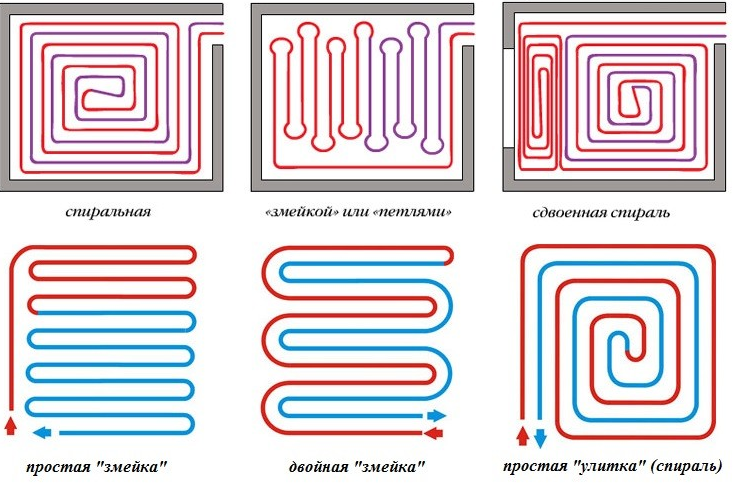
To install a warm floor with your own hands, the step between the turns should be from 10 to 30 cm. In most cases, 30 cm is enough. In areas with significant heat loss, you can reduce the step to 15 cm. screed with a maximum length of 80 m ( perfect option- up to 50 m).
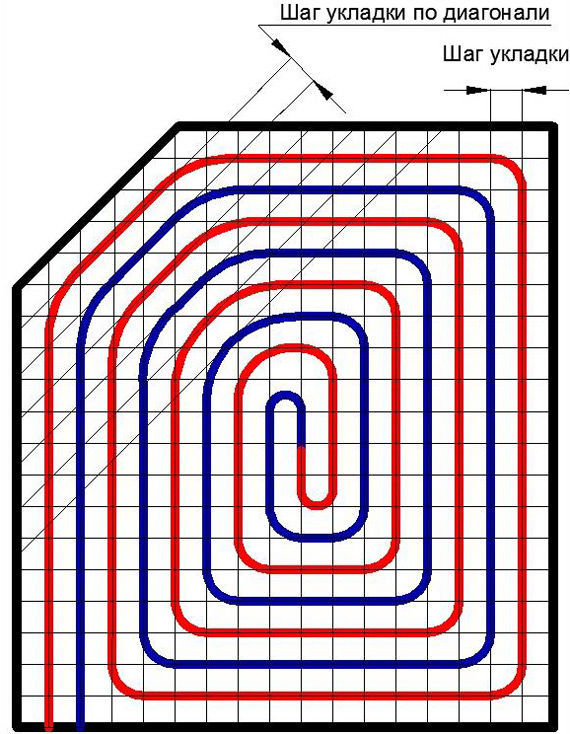
To calculate the required number of pipelines, you can use graph paper. On it, a plan of the room is drawn on a scale, where a diagram of a warm floor is depicted. By measuring the length of the circuit, you can navigate the required number of pipes. It is also easy to find out if you use a regular thread. It is laid on the floor according to the scheme that is chosen for the device of a warm floor.
After all the manipulations, it is enough to measure the length of the thread, which will correspond to the footage of the pipelines. When using any option, you need to increase the required volume by 10%.
Pipe laying
For laying polypropylene pipes in a screed, it is recommended to use the "spiral" scheme. In this way, it is possible to ensure a more uniform heating of the surface and facilitate installation. The pipes will be laid with a large radius, which is not the case when using the "snake" scheme.
To fix the water circuit, a metal mesh is laid on the prepared base. It will also strengthen the screed layer, which will last a longer period. Pipes are attached to the grid using metal wire or plastic clamps.
The installation of these elements should be done every 0.8 m. The fasteners should not be overtightened so as not to cause deformation of the pipes. They can also be fixed directly to the thermal insulation using dowels.
Final stage
After installing the water circuit, you need to connect it to the collector group. One end is connected to the supply, the other to the return. After connecting to the collector, it is necessary to test the heating system. This can be done by running the coolant into the warm floor. The pressure of the system must be higher than the working one, but not more than 6 bar.
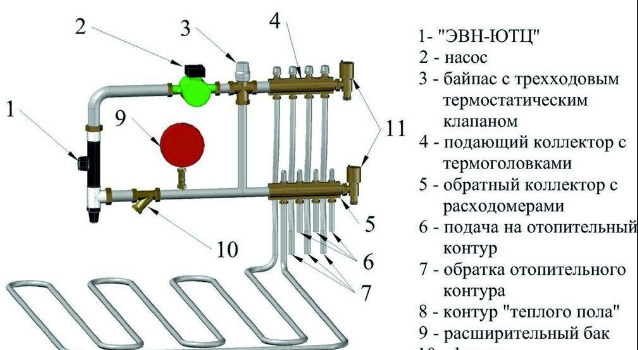
Every half an hour you need to raise its level to the previous level. Such actions are repeated three times, after which the floor heating is left alone for 24 hours. If during this time the pressure drops by no more than 2 bar, then the installation was successful. At the last stage, they move on to the screed. When it dries, you can start laying the flooring.
Video: Soldering polypropylene pipes
Secrets of the treatment of joint pain from our regular reader.
Hello!
My name is Gennady Alekseevich. I am a baker with over 20 years of experience. I am engaged in both repair and construction of Russian stoves and fireplaces. I always perform the work very efficiently and carefully, which negatively affects the condition of the joints. As I got older, the pain got worse and worse, to the point where I could no longer work. Having tried many medications and folk ways treatment, I realized how serious my disease was, since there was no positive effect. Until I came across one tool, which I want to tell you about.
It is a unique blend of the rarest and most powerful natural healing substances. This tool has proven its effectiveness not only to patients, but also to science, which has recognized it as an effective drug. Pain in the joints and back go away in 10-15 days, studies have shown. The main thing is to strictly follow the instructions in the methodology. You can order the product in the original packaging, with a quality guarantee, at


